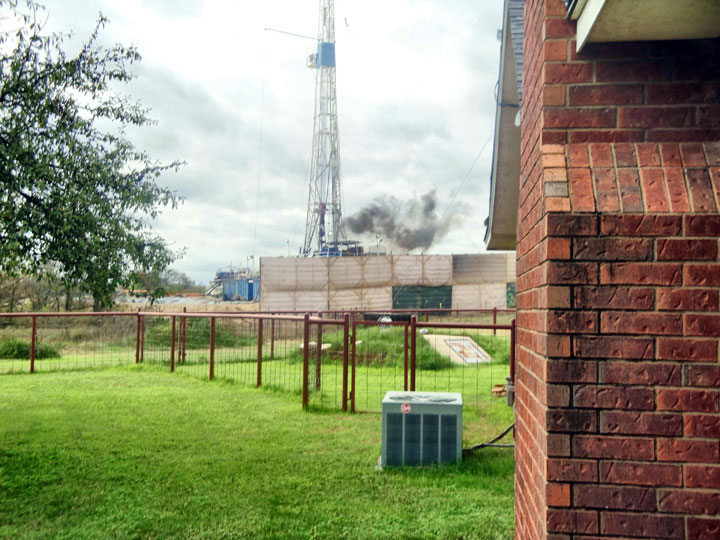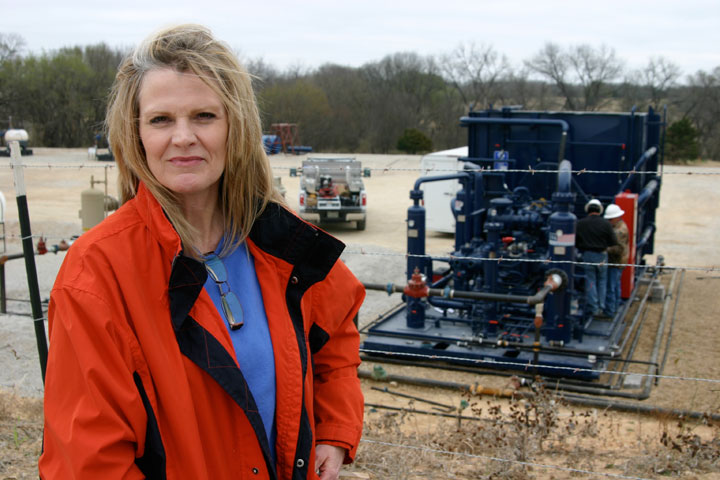In North Texas these days, it seems like you can’t drive 50 feet down the highway – or even a neighborhood feeder road – without spotting another gas well or compressor station or a well pad waiting to be drilled. In fact, the only thing growing faster than wells in the Barnett Shale may be the number and seriousness of the questions being raised about the environmental costs of the boom.
 Some of the basic problems with shale gas production have been known and debated for several years – noise, the potential for air pollution and the poisoning of wells and creeks, the dangers of fire and explosions. But as scary as those threats are – threats backed by increasing amounts of scientific and anecdotal evidence – the list of previously little- known dangers continues to grow, as the essentially unregulated nature of the gas drilling industry becomes clearer.
Some of the basic problems with shale gas production have been known and debated for several years – noise, the potential for air pollution and the poisoning of wells and creeks, the dangers of fire and explosions. But as scary as those threats are – threats backed by increasing amounts of scientific and anecdotal evidence – the list of previously little- known dangers continues to grow, as the essentially unregulated nature of the gas drilling industry becomes clearer.
ProPublica, the Manhattan-based nonprofit investigative journalism web site, recently reported on a list of technology changes and strategies that the drilling industry could use to reduce its environmental toll. And yet, the online news organization reported, the techniques are used only intermittently across the country, including in Texas. The industry is required to provide only minimal documentation of what it is putting into the air, water and soil, and there are currently few legal requirements that could force the industry to limit its emissions.
As shale drilling increases in places like Pennsylvania and New York, the controversy has gone national. Some North Texans feel as though they’ve been the guinea pigs for the country, with other regions learning from our bad example. On the other hand, the increased attention to air and water quality degradation in those states could provide the national pressure that could bring about change here.
But in at least one instance that has residents, activists, and scientists worried, Texas apparently is becoming not only a proving ground for shale drilling but a dumping ground for toxic wastes from that industry.
According to Wilma Subra, a Louisiana environmental consultant who has worked as a technical consultant with many community groups, much of the drilling wastewater from the Haynesville shale field in Louisiana – which rivals the Barnett in size – is being trucked to Texas and disposed of in injection wells here. That’s millions of gallons of toxic waste per well.
“There are no rules against it,” she said.
It’s being done, she said, because the geologic formations underlying the Haynesville field can’t provide enough capacity, in wastewater injection wells, to hold the full volume of the toxic soup of drilling “frac” water being produced in the Louisiana shale field. The companies that are trucking their wastes to Texas for disposal, she said, include many of those already operating here. Chesapeake Energy, for instance, is a major player in the Haynesville Shale.
Chesapeake officials did not respond to questions for this story.
Gary Hogan, who served on both of Fort Worth’s gas drilling task forces and who has continued to fight, with little success thus far, for environmental controls on shale drilling, said the news that millions of gallons of Louisiana “frac” water are being injected underground in Texas is worrying.
Despite assurances from the industry that such disposal wells are safe, he said, “I’ve always had concerns about how much of this crap they can pump [into injection wells] before the ground starts barfing it back up” or the rock formations into which the liquids are being pumped become destabilized. “There has to be some limit to the capacity,” he said. “And I just don’t believe anything these folks say anymore.”
Complaints about the environmental toll of shale drilling are no longer the province just of scattered Western farmers and ranchers or of Fort Worth home owners whose complaints get discounted because, well gosh, they’re already taking the gas company’s money for mineral leases, aren’t they? Those cries in the wilderness are echoing now in New York, Pennsylvania, Louisiana, New Mexico, Colorado, and other states.
 New York is worried about gas drilling operations contaminating the water supplies for New York City itself. The state’s Department of Environmental Conservation raised the “green” issue in its recent environmental review for drilling in the Marcellus Shale formation.
New York is worried about gas drilling operations contaminating the water supplies for New York City itself. The state’s Department of Environmental Conservation raised the “green” issue in its recent environmental review for drilling in the Marcellus Shale formation.
In New Mexico, Gov. Bill Richardson’s administration, concerned that seepage from drilling waste pits had contaminated water supplies in hundreds of cases, passed some of the nation’s strongest rules prohibiting unlined pits and encouraging what is called the closed-loop system of dealing with drilling wastewater – and then had to relax some of the requirements in the face of a major industry lobby initiative.
Last winter, tests showed levels of ozone in Sublette County, Wyoming that were high enough to breach federal air quality laws usually applied to big cities. Pushed by the U.S. Bureau of Land Management, which controls major areas of public land in the county, gas companies took a number of steps to curb the pollution.
The debate over the safety of natural gas drilling has intensified in the past year, even as the nation increasingly turns to cleaner-burning natural gas as an alternative to oil and coal. In Congress, one group of politicians is writing a climate bill that would encourage the use of more natural gas, while another group is pushing a bill that would put a key part of the process under federal regulation and force the disclosure of chemicals used in the drilling process. Neither bill addresses the question of how to encourage energy companies to use existing techniques that lower the risks of environmental damage.
In Fort Worth, Hogan and others said, the drilling industry has pressured city officials not to implement environmental controls by threatening to abandon or minimize drilling activity here and shift their focus – and therefore their profits – to the Marcellus Shale in the Northeast or to Louisiana or some other region where, allegedly, conditions are friendlier and controls less onerous.
“They try to scare [Mayor Mike] Moncrief by saying, ‘If there’s too much regulation, we will go to Haynesville and to hell with the boom here,’ ” Hogan said. “But I’m in the know. In Pennsylvania, in Louisiana, they’re telling those people the same thing – but there the companies are saying, ‘We’ll go to the Barnett. They’re letting us do it there.’ “
Texas Railroad Commission officials said they could not respond to Fort Worth Weekly‘s questions about “green” practices in gas drilling in time for this week’s article, and the Texas Commission on Environmental Quality referred all questions to the Railroad Commission. But in Louisiana, gas drilling regulators were happy to talk with a reporter about a practice in their state that is affecting Texas.
Gary Snellgrove, director of the environmental division of Louisiana’s Office of Conservation, confirmed that at least part of the load of drilling wastewater from the Haynesville field in the northwest part of his state is winding up in injection wells in Texas.
 Gas companies operating in northwest Louisiana do have some deep injection wells of their own for disposing of fluids from the frac process. Snellgrove said that a couple of commercial waste disposal firms also contract with drillers to dispose of the waste in the disposal company’s own injection wells and that other waste is trucked to Texas and Arkansas. The fluid falls under the category of exploration and production waste, and Louisiana law requires that each load be registered, with paperwork following it from where a load is picked up to where it is finally disposed of.
Gas companies operating in northwest Louisiana do have some deep injection wells of their own for disposing of fluids from the frac process. Snellgrove said that a couple of commercial waste disposal firms also contract with drillers to dispose of the waste in the disposal company’s own injection wells and that other waste is trucked to Texas and Arkansas. The fluid falls under the category of exploration and production waste, and Louisiana law requires that each load be registered, with paperwork following it from where a load is picked up to where it is finally disposed of.
Snellgrove said he didn’t know what percentage of Haynesville drilling waste fluid is exported to Texas. He said he assumes that economic factors are part of what drives that decision by drilling companies. “These [geologic] formations do have limitations” on their capacities, he said. “You can only put water down there at a rate [less than what] would fracture the formation” and thus allow the chemical-laced fluid to drain away, possibly polluting groundwater. “There is a lot of [drilling] water being generated” in the Haynesville Shale, he said.
Subra, the Louisiana environmental consultant, said there are no rules against the Haynesville drilling waste being shipped to other states for disposal. She is on the board of Earthworks, a nonprofit public interest group that helps communities in many countries deal with the destructive impact of mineral development.
Each well drilled could produce two to five million gallons of used frac fluid, and Subra said she has been told that most of it is coming to Texas.
Waste disposal is one of the industry’s toughest headaches. “In the long term the biggest problem is going to be wastewater treatment,” said Matt Pitzarella, spokesman for Range Resources, one of the players in the Marcellus Shale. “And we have to figure out how to deal with it.”
The reason that disposing of used frac water is tough is that “saltwater” – as the industry calls it – is typically laced with heavy metals, chemicals, and hydrocarbons Usually the waste is collected in open, dirt-brimmed waste pits where it sits until it’s hauled off to treatment facilities or injection wells. In the meantime, the fluids can evaporate or seep into the earth, or overflow if rain or snow overfills the pit.
 A 1992 congressional report found that one of “the greatest opportunities” to prevent this type of pollution is something called a closed-loop system, a series of pipes that gather the waste as it comes out of a gas well, separates some of the water for reuse, and confines the concentrated leftovers in a steel tank. The EPA estimated that closed-loop systems could reduce the volume of drilling fluids by more than 90 percent, reducing evaporation of chemicals into the air and also the chance of spills. (Of course, the concentrated wastes left over still have to be disposed of properly.)
A 1992 congressional report found that one of “the greatest opportunities” to prevent this type of pollution is something called a closed-loop system, a series of pipes that gather the waste as it comes out of a gas well, separates some of the water for reuse, and confines the concentrated leftovers in a steel tank. The EPA estimated that closed-loop systems could reduce the volume of drilling fluids by more than 90 percent, reducing evaporation of chemicals into the air and also the chance of spills. (Of course, the concentrated wastes left over still have to be disposed of properly.)
Closed-loop systems are rarely required in state regulations, but they are increasingly used, in part because they can save money for the companies that use them. A 2001 case study by the Texas Railroad Commission found that a small gas producer that tested such a system saved at least $10,000 per well, by deleting the need to build waste pits or remediate the land after drilling, and by reducing the volume of toxic material to be hauled off and disposed of.
Subra said that in Texas access issues rather than environmental concerns seem to drive companies’ decisions about whether to use closed-loop systems – closed loops are used more in residential areas, but open pits are still common in rural areas.
All kinds of problems associated with drilling could be reduced if the “frac” fluid that drillers pump into the ground under high pressure were less toxic. In some cases, more than 40,000 gallons of frac fluid can be used in a single well. ProPublica’s review of scientific studies, plus interviews with drillers and chemists who supply the chemicals, showed that a transition to “green” or nontoxic drilling fluids is beginning.
EnCana, a Canadian company that operates on both sides of the border, recently said it stopped using 2-Butoxyethanol, a solvent that has caused reproductive problems in animals. BJ Services, one of the largest fracturing service providers in the world, has discontinued the use of fluorocarbons, a family of compounds that are persistent environmental pollutants.
Neither company would say what it is using instead. But David Holcomb, director of research for the Texas-based drilling chemistry company Frac Tech, said he uses orange citrus to replace some solvents and palm oil in place of a common slicking agent that has been prohibited in Europe but is still allowed in the United States.
The “single biggest move” the industry has made to reduce the toxicity of its fluids, according to David Dunlap, chief operating officer for BJ Services, is phasing out diesel fuel, a solvent that contains the potent carcinogen benzene. Companies began shifting away from diesel in frac fluid in 2003, after the EPA pressed the nation’s dominant fracturing companies to voluntarily eliminate diesel from some of their fluids, he said.
“It sounds like a simple thing, but it’s the largest single volume other than water that is used in a frac job,” said Dunlap, whose company is being acquired by Baker Hughes, the international drilling company. BJ no longer uses diesel in its fracturing fluids, Dunlap said, though it may still be used in other applications.
Subra said the drilling industry indeed made a voluntary commitment, at the EPA’s request, to quit using diesel in fraccing. But she and Texas activists in Texas are skeptical about whether the companies have indeed quit using it.
“They’re not telling us what chemicals are being used,” Subra said, and drilling crews have told her that they make decisions about what goes into the frac cocktail on a well-by-well basis.
“How would we know?” whether diesel is still being used, asked activist and blogger Sharon Wilson, who has helped connect Texans concerned about shale drilling with property owners and worried folks in other shale areas across the country. “If they’re not using diesel, how does so much of it get into the drilling waste?”
Because there are no laws that dictate what chemicals can be used for drilling on U.S. soil – and because most companies still keep the exact makeup of their fluids a secret from state and federal regulators – the definition of “green” frac fluid remains subjective.
In New York, state environmental officials raised the issue regarding drilling in the Marcellus Shale. “It may not be feasible to require the use of ‘green’ chemicals because presently there is no … chemicals approval process in place in the U.S.,” the officials reported.
Actually, such standards do exist, but only for offshore drilling. Both European law and the regulations of the U.S. Minerals and Management Services dictate that chemicals used in the North Sea and the Gulf of Mexico be safe enough that they won’t kill fish and other organisms if they are dumped overboard.
“You can always do it,” said Dunlap, whose company has been a leader in innovating sustainable materials. But the cleaner chemistry costs more and is justifiable to his shareholders only when regulations leave no choice, he said.
Natural gas is mostly methane, a greenhouse gas that the U.S. produces more of than any country except Russia. According to the EPA, oil and gas drilling and production are responsible for 18 percent of all methane emissions caused by humans. It’s an area where some drillers are working to do a better job – and saving themselves money in the process.
Under the guidance of an EPA program, EnCana is using infrared cameras to find and seal methane leaks on wells and pipelines that would otherwise be invisible, sharply curtailing levels of some of the most dangerous heat-trapping atmospheric gases. According to Richard Haut, project director for the Houston Advanced Research Center, a partner on the Environmentally Friendly Drilling Project, such programs could pay for themselves within two years and then turn a profit as the extra gas captured goes to market.
And indeed, manufacturers have told Subra, Wilson, and others that they are selling lots of those cameras to companies in the Barnett Shale. But the companies operating here don’t necessarily publicize their use of the cameras – because right now they are not required to tell anyone about how many leaks the cameras are helping them find.
The companies “have to do leak tests. But they can go out and find it and fix it and never have to report it,” Subra said.
 “We’ve known about leaks in the Barnett Shale for at least a year and a half,” Wilson said. “We’ve looked through these cameras and seen big plumes leaking out, but we haven’t known what was leaking.” Only after she and Fort Worth environmentalist Don Young publicized some of the videos of such plumes, taken by state regulators, has official attention begun to be paid to what is leaking from compressor stations as well as wells and pipelines.
“We’ve known about leaks in the Barnett Shale for at least a year and a half,” Wilson said. “We’ve looked through these cameras and seen big plumes leaking out, but we haven’t known what was leaking.” Only after she and Fort Worth environmentalist Don Young publicized some of the videos of such plumes, taken by state regulators, has official attention begun to be paid to what is leaking from compressor stations as well as wells and pipelines.
When official pressure gets applied, the industry has also found ways to reduce carbon dioxide emissions from trucks and processing plants and ozone-causing volatile organic compounds. In Wyoming’s Sublette County, Questar Exploration and Production, a prominent Rocky Mountain drilling company, eliminated 62,000 truck delivery trips and the accompanying diesel exhaust by building a network of pipes to transport its fluids.
EnCana began using natural gas instead of diesel fuel to power its 150-foot-tall drilling rigs, a seemingly small change that resulted in 85 percent less volatile organic compounds being spewed into the air. EnCana also installed other, less polluting new equipment, including refinery-grade combustors.
Doug Hock, a spokesman for EnCana, said the company has spent $25 million on such efforts since 2005. Being allowed the flexibility to develop new greener technologies, rather than “blanket mandates” is what will ensure that gas fields will continue to reduce their impact on the environment, he said.
But the industry’s efforts in Sublette County were triggered by an aggressive push by the federal government. Before the U.S. Bureau of Land Management allowed more drilling on public land there, companies had to agree to reduce their emissions.
“There is kind of a big hammer hanging over their heads,” said Chuck Otto, the BLM field manager there.
In Texas, up until now, there has been no such hammer.
“Really, the industry in Texas is completely on the honor system,” said Sharon Wilson. “For instance, in 30 percent of [drilling industry] spills, an inspector never comes out.” And even when they do, she said, they must depend largely on what the company says happened.
If there’s a drilling mud spill that needs to be analyzed to see what chemicals escaped, “they take it to [some] mud service that operates out of a guy’s garage and that only tests for the industry. I saw a copy of a recent spill report, and it was laughable. He supplies the mud; he works for the operators. Is he going to say it’s toxic? Probably not.”
She and most of the other activists who have been fighting for reform of gas drilling practices aren’t impressed with whatever progress the industry has made in Texas toward being more environmentally responsible.
Take the massive emissions from the compressor stations lined up on the edge of DISH. There, studies ordered by outspoken mayor Calvin Tillman have shown that the residents are breathing dangerously polluted air, where trees and animals are sick and dying, and serious health problems have begun to appear among the human beings as well. Companies could use special valves, scrubbers, and vapor-recovery devices to eliminate the “fugitive emissions” from those stations, Wilson said, but they don’t do it because they aren’t forced to.
Then there are issues like “green completion” of wells, which means that a just-drilled well is vented into a pipeline, rather than pushing all the polluted air in the system out into the atmosphere. Gas operators in Fort Worth are required in some cases (many well sites are grandfathered) to use the process only after the first well has been completed – because gas companies don’t want to lay the pipeline to the well until after the drilling is done. But Subra and others said that, because there’s no such thing as a dry hole in “frac” drilling, there’s no reason that companies couldn’t put the pipelines in first and vent every well into the line rather than the open air.
No reason except money and politics, Hogan said. Because if mineral rights owners realized that pipelines were going to take out parts of their front yards, he said, they might not have been so eager to sign mineral leases. “They want to establish their wells and then spring on people the infrastructure and pipelines and compressor stations that will be needed to support it. If they came with pipelines first, everybody would say, ‘Whoa.’ “
Wilson said that when she visits her friends in Wise County, emissions from the surrounding gas fields are so intense that they turn the sky black. “You look around and the sky is blue everywhere else, and then a couple of blocks on either side of their place it will be black,” she said. “They sit in a bowl beneath what looks like a black storm cloud.”
For residents who start delving into the myriad environmental implications of the drilling that’s going on all over North Texas, she said, more knowledge brings more fear. “The more you learn about it … it’s like you could get post-traumatic stress syndrome,” she said.
That’s why Wilson and other members of the Texas Oil and Gas Accountability Project have been working with Subra and other experts for more than a year to develop a plan for what needs to happen to clean up the Barnett Shale. They’re planning to release it in the next few weeks.
“It’s a plan to bring Texas regulation along to where it needs to be to protect our air, our land, our water, and so surface land owners will have a better deal,” Wilson said. In a way, it’s a blueprint for legislation, she said, “and it’s about time.”
On many different points regarding environmental practices in the Barnett Shale, even the staunchest critics of the drilling industry say that Devon Energy does a better job than most – and that their record shows that all shale drillers could do a better job and do it economically.
Devon, which works more in rural areas than in Fort Worth proper, had one of the earliest programs in recycling frac water. And Hogan said the company uses green-completion techniques on almost 90 percent of their wells.
 Wilson said she has been told that the company uses a closed-loop system routinely and that company officials have gone on record as saying that no drillers in the Barnett Shale need to vent their wells to the atmosphere or “flare” or burn off the resulting emissions. “Devon is by no means a model … but they do a better job than some other operators,” she said.
Wilson said she has been told that the company uses a closed-loop system routinely and that company officials have gone on record as saying that no drillers in the Barnett Shale need to vent their wells to the atmosphere or “flare” or burn off the resulting emissions. “Devon is by no means a model … but they do a better job than some other operators,” she said.
Company spokesman Chip Minty said Devon’s water-recycling effort is going well. “We pioneered this method in 2004 … and it was later sanctioned by the Railroad Commission as a method of treating water in the Barnett,” he said. “We have used it to treat all the water we recover from our hydraulic fracture completion projects.”
The company uses mobile units that move from well to well to remove as many chemicals as possible so that the water can be re-used in fraccing the next well. “In 2008 we were at full [drilling] capacity, using nine [mobile] units to support our drilling program, which involved nearly 40 drilling rigs in the Barnett,” he said.
Minty said Devon recovers about 30 percent of the 2 to 3 million gallons of water used on a typical well drilling. Of that recovered amount, he said, “we’re able to reclaim about 80 percent … . It reduces the amount of water we require from local resources.” Overall, recycled water accounts for about 15 percent of what the company uses, he said.
The method is approved, but not required, by the Railroad Commission. So why does Devon do it? “It’s better for the environment,” Minty said. “This is one way we can contribute.” The same goes for the company’s efforts in reducing emissions and other programs, he said. “It improves the quality of life for our employees and their families and the people who live and work next to us.”
The gas industry’s long-term lobbying effort to avoid environmental controls, including getting itself excluded from the provisions of the Clean Air Act, potentially could backfire on them in coming years. Environmental damage in places like DISH has become undeniable, and there are now thousands of people in Texas alone who have seen their property ruined or left valueless by eminent domain takings, fouled water supplies, and other environmental problems. The damage cuts across county lines, party lines, economic classes, rural and urban divisions, and lots of congressional districts. Groups like Texas OGAP, with chapters in many other states, and the recently formed North Central Texas Communities Alliance, are bringing scattered opponents together in broad-based coalitions. Legislative pressure for regulation seems to be growing in Congress.
One guest columnist in Pennsylvania, an engineer who said he has worked on energy policy issues for half a century, recently uttered the unthinkable: He suggested that the federal government, specifically the EPA, should take over regulation of the oil and gas industry.
If regulation continues to be left to the states, Forrest Remick wrote in the Times-Tribune in Scranton, Pa., “with the health and safety of millions of people at stake, the temptation to ignore the risks of natural gas drilling on a massive scale … could be a calamitous mistake.”
Hogan said he thinks Fort Worth has been “the guinea pig for North Texas,” demonstrating the harm that can occur when officials refuse to provide little meaningful regulation of drilling. “I wish Calvin Tillman was our mayor, that we had that kind of strong voice,” he said. “Then we could be the pride of the country and show everybody how it could be done right.”
Jerry Lobdill, a retired North Texas chemist and physicist, said he holds little hope that the oil and gas industry will change in any significant way without the threat of legal repercussions.
“The industry has been reckless for 150 years,” he wrote to Fort Worth Weekly. “They are a rogue industry that has gotten too big to regulate.” Even with the recent attention to air quality problems in North Texas and water and air quality concerns in New York, Pennsylvania, and western states, there are many other serious problems that even now have not been brought to public attention though the industry knows about them, he said. An example: Even though he pays closer attention than most people to what is happening in shale gas development, he said he had not heard about the Louisiana frac water being exported to Texas.
“The bottom line is that the victims have to discover what their predators are doing to them, while the predators know full well what is going on,” he said. The “green” techniques being discussed now, he said, won’t fix the problems “even if the industry can be arm-twisted into adopting them.”
Jeff Prince contributed to this story.
A substantial part of the reporting for this story was done by ProPublica, an independent, investigative newsroom.
To read more of ProPublica’s stories about natural gas drilling, visit www.propublica.org/drilling.











